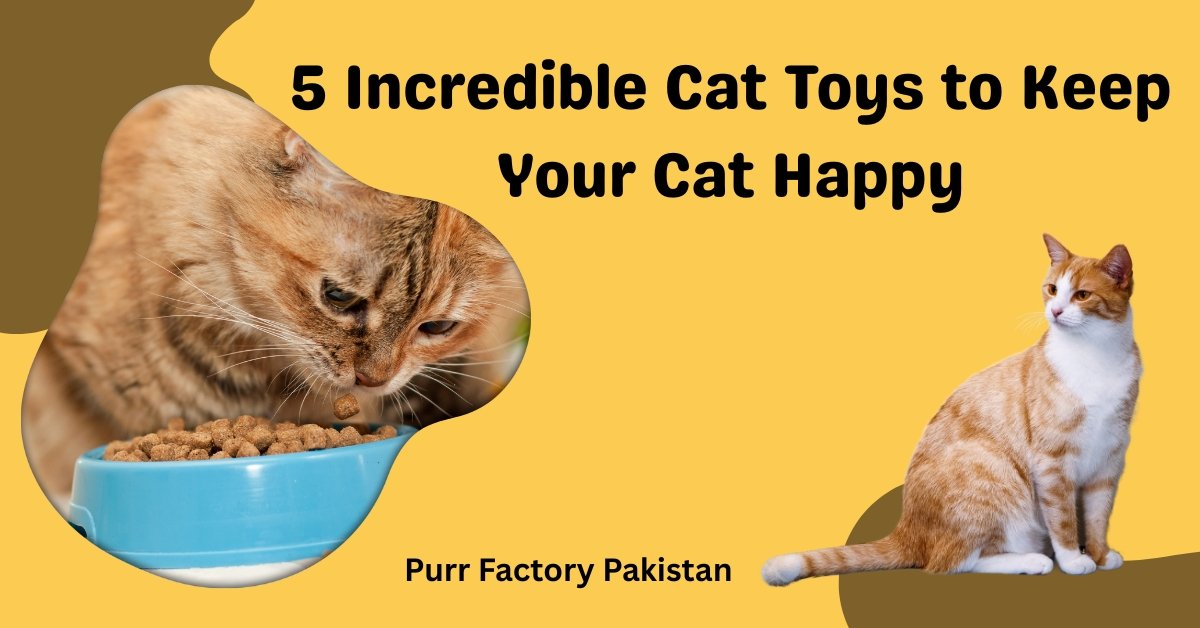5 Incredible Cat Toys to Keep Your Cat Happy
Cat toys play a vital role in keeping your feline friend mentally stimulated, physically active, and emotionally happy. Cats are natural hunters by instinct.
In the wild, they spend hours stalking, chasing, and catching prey. However, indoor cats do not get these opportunities, which can lead to boredom, obesity, and destructive behaviors like scratching furniture or excessive meowing.
Providing the right toys can help mimic their natural hunting behavior, keeping them entertained and healthy.
Regular play sessions with engaging toys not only prevent behavioral problems but also strengthen the bond between you and your pet.
According to a 2023 study by the Journal of Feline Medicine and Surgery, cats that engage in 20–30 minutes of active play daily show improved mood, better weight control, and reduced stress levels.
From puzzle feeders to interactive electronic toys, there are plenty of ways to keep your cat’s mind and body active.
5 Incredible Cat Toys to Keep Your Cat Happy
In this guide, we will explain five incredible cat toys that will keep your cat happy, healthy, and active every single day.

Interactive Puzzle Feeders – Mental Stimulation & Slow Feeding
Interactive puzzle feeders combine playtime with feeding, giving cats both mental stimulation and a slower, more controlled eating experience.
These toys are designed to mimic hunting behavior by requiring cats to work for their food. Instead of simply eating from a bowl, cats must paw, nudge, or manipulate the feeder to access their kibble or treats.
Puzzle feeders are especially beneficial for cats that tend to eat too quickly, as they naturally slow down mealtime and reduce the risk of digestive problems such as vomiting or bloating.
They also provide valuable mental exercise, which is crucial for indoor cats that do not get the same level of stimulation as outdoor cats.
When selecting a puzzle feeder, consider your cat’s skill level. Beginners may benefit from simple designs with visible openings, while experienced cats may enjoy more complex puzzles that require problem-solving.
Dry food works best in these feeders, but small treats can also be used for added motivation.
To keep your cat engaged, rotate puzzle feeders regularly and gradually increase the difficulty as they become more skilled. This not only prevents boredom but also encourages continued learning and problem-solving.
For optimal results, incorporate puzzle feeders into your cat’s daily routine by replacing one or more regular meals with puzzle playtime.
This approach promotes healthy eating habits, provides entertainment, and strengthens their natural instincts.
2. Wand Toys – Simulating the Hunt
Wand toys are a must-have for cat owners because they replicate the movement of prey, which stimulates a cat’s natural hunting behavior.
These toys usually consist of a stick with a dangling object such as feathers, strings, or small plush shapes that move unpredictably when you control them.
Engaging in active play with wand toys gives cats the opportunity to stalk, chase, and pounce, just as they would in the wild. This kind of exercise is important for maintaining muscle tone, coordination, and overall physical health.
The key to successful play with wand toys is mimicking realistic prey movements. Avoid simply swinging the toy in front of your cat.
Instead, move it in a way that resembles a bird fluttering or a mouse scurrying along the floor. Vary the speed and direction to keep your cat challenged and interested.
Play sessions should last about 10 to 15 minutes and can be repeated two or three times a day. This not only satisfies their need for exercise but also helps reduce stress and anxiety.
Additionally, ending each play session by allowing your cat to “catch” the toy helps them feel a sense of accomplishment, which is vital for their mental satisfaction.
Wand toys are affordable, easy to store, and suitable for cats of all ages. Always supervise your cat during play to prevent accidental injury or chewing on strings.
3. Catnip and Silvervine Toys – Natural Mood Boosters
Catnip and silvervine are natural herbs that have been proven to enhance play behavior in cats.
Catnip contains a compound called nepetalactone, which activates a cat’s sensory receptors, triggering playful behavior such as rolling, batting, and jumping.
Silvervine works in a similar way but has been shown to affect a higher percentage of cats, making it a great alternative for those who do not respond to catnip.
Toys infused with catnip or silvervine can provide both mental stimulation and relaxation. When cats interact with these toys, they often exhibit bursts of energy followed by a calm, satisfied state.
This makes them ideal for reducing stress and anxiety, especially in multi-cat households or for cats that spend long hours alone.
There are many types of catnip toys available, including plush mice, kickers, and refillable pouches.
Kickers are particularly effective because they allow cats to grab and “bunny kick” with their back legs, which mimics hunting behavior.
To maintain the potency of catnip toys, store them in a sealed container when not in use. Limit play sessions to a few times a week, as constant exposure may reduce your cat’s sensitivity to the herb.
Silvervine toys are often available in stick form or mixed with other herbs for added appeal. Like catnip, these toys should be introduced gradually and used as a special treat to keep your cat excited and engaged.
4. Interactive Electronic Toys – Solo Play When You’re Busy
Interactive electronic toys are perfect for keeping your cat entertained when you cannot be around to play. These toys move on their own, providing stimulation and exercise without requiring direct interaction from you.
Some popular designs include rolling balls, laser toys, and automated prey simulators that move unpredictably to keep your cat engaged.
These toys are especially beneficial for high-energy cats or households with multiple cats that need simultaneous entertainment.
Electronic toys help prevent boredom, which can lead to destructive behaviors such as scratching furniture or excessive vocalization. They also encourage physical activity, which is essential for maintaining a healthy weight and preventing obesity-related health issues.
When selecting an electronic toy, choose one with adjustable speed and motion settings to match your cat’s activity level. Look for durable materials, as some cats can be rough during play.
While these toys are designed for independent use, it’s best to supervise your cat during the initial sessions to ensure they interact safely. Regularly check batteries and moving parts to prevent malfunctions.
To keep things interesting, rotate electronic toys with manual toys such as wands or puzzle feeders. This variety will prevent your cat from becoming bored with repetitive play patterns.
5. Scratching Posts with Toys – Dual Purpose Play
Scratching is a natural and necessary behavior for cats. It helps them maintain healthy claws, stretch their muscles, and mark territory.
Providing a designated scratching post prevents damage to furniture and carpets while giving your cat a safe outlet for this instinct.
Scratching posts with built-in toys offer additional engagement. Many models include dangling feathers, balls, or tunnels attached to the post, combining physical activity with mental stimulation.
These multi-purpose play stations are particularly useful for small living spaces, as they serve multiple functions in one area.
When choosing a scratching post, look for one with a sturdy base to prevent tipping during vigorous play. The post should be tall enough for your cat to stretch fully while scratching. Materials like sisal rope are ideal for durability and texture.
Position the scratching post in areas where your cat spends the most time, such as near windows, resting spots, or entrances.
If your cat has already developed a habit of scratching furniture, place the post near the targeted area to redirect their behavior.
To encourage use, sprinkle a small amount of catnip on the scratching surface or dangle an attached toy to attract attention. Over time, your cat will naturally gravitate toward the post instead of unwanted surfaces.
Practical Tips for Cat Toy Rotation
Cats can lose interest in toys if they are always available. To keep play sessions exciting and engaging, implement a toy rotation system.
Start by dividing your cat’s toys into groups. Offer only one or two groups at a time, then rotate them weekly. When a toy is reintroduced after a break, it feels new and exciting to your cat.
Combining different types of toys, such as puzzle feeders, wands, and electronic toys, provides variety and stimulates different senses. This approach prevents boredom and keeps your cat motivated to play.
Schedule daily play sessions at consistent times to create a routine. Cats thrive on predictable patterns, and regular play reduces stress and anxiety.
Finally, reward your cat with a small treat or gentle petting at the end of each play session. This positive reinforcement builds trust and strengthens the bond between you and your pet.

Signs Your Cat Thrives on Play
Regular playtime has clear benefits for your cat’s physical and mental health. Here are signs that indicate your cat is thriving as a result of consistent play:
- Increased energy and curiosity throughout the day.
- Healthy weight and muscle tone from regular exercise.
- Reduced destructive behaviors such as scratching furniture or chewing on inappropriate items.
- Relaxed body language, including purring and slow blinking after play sessions.
- Improved sleep patterns and reduced nighttime restlessness.
If your cat shows little interest in play or exhibits signs of aggression or lethargy, consult a veterinarian. Lack of engagement may indicate underlying health issues that need attention.
Conclusion
Keeping your cat happy and healthy goes beyond providing food and shelter playtime is essential for their overall well-being.
The right cat toys not only keep your feline friend physically active but also stimulate their natural instincts and prevent boredom.
When cats have engaging toys like puzzle feeders, wand toys, catnip kickers, interactive electronic toys, and scratching posts with built-in play elements, they are less likely to develop destructive behaviors and more likely to maintain a healthy weight and balanced mood.
Consistency is key. Scheduling regular play sessions, rotating toys, and offering a mix of physical and mental challenges create a fulfilling environment that mimics the excitement of the outdoors while keeping your cat safe inside.
Remember to supervise playtime when introducing new toys and adjust according to your cat’s age, health, and energy levels.
By investing in quality toys and dedicating just a few minutes each day to interactive play, you will not only improve your cat’s quality of life but also strengthen your bond with them.
A playful, stimulated cat is a happy cat, and a happy cat means a happier home for you too.
Related Articles
